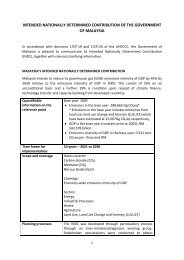RP-01638
RP-01638
RP-01638
Create successful ePaper yourself
Turn your PDF publications into a flip-book with our unique Google optimized e-Paper software.
program is being curtailed by the lack of the<br />
30% counterpart financing that is a prerequisite<br />
for obtaining "soft" loans from the<br />
World Bank (World Water 1982).<br />
Only a limited number of handpumps exist<br />
at present, whether locally manufactured or<br />
imported. The imported pumps corne either<br />
from India or Bangladesh and, for shallow<br />
wells, cost about $100-250 each. In view of<br />
their limited usage and the lack of experience<br />
in their construction, there are no data on<br />
either their cost or reliability.<br />
Provided that funds are not a constraint,<br />
the potential demand for the IDRC-sponsored<br />
PVC pumps is approximately 20000 pumps<br />
per year between now and 1990. This is based<br />
on the assumption that at least half the rural<br />
population can be served by shallow wells and<br />
that each pump serves five households.<br />
Thailand<br />
After some laboratory testing, a modified<br />
version of the below-ground composent of<br />
the IDRC-sponsored PVC pump was installed<br />
in 54 selected wells in central, northeastern,<br />
and northern Thailand. These wells were<br />
being used daily by villagers, and had been<br />
fitted with a Department of Minerai Resources<br />
(DMR) (Demster or Red Jacket) or an Accelerated<br />
Rural Development (ARD) (modified Korat)<br />
pump. The project team retained the aboveground<br />
components of these 54 pumps and<br />
only altered the below-ground components.<br />
Thus the pump that was tested was made up<br />
of a combination of plastic and cast-iron<br />
components.<br />
These pumps were field tested for 15 months<br />
and the results were generally satisfactory.<br />
The major problem encountered initially was<br />
that of foot-valve leakage, especially in sandy<br />
areas where sand particles lodged under the<br />
plate valve and caused the leakage. However,<br />
after some modifications to the design, this<br />
problem appears to have been solved.<br />
The Asian Institute of Technology (AIT)<br />
group also designed a new PVC pump that<br />
had both above- and below-ground components<br />
of PVC, but only three of these<br />
pumps were tested in the field. The project<br />
team considers that the IDRC-PVC handpump<br />
can be used for wells to a maximum<br />
depth of 65 feet (20 m).<br />
The drilled depth of the selected wells<br />
ranged from 52 to 112 feet (16-34 m). However,<br />
the water level ranged from 4.9 to 52<br />
feet (1.5-16 m). The water level in most wells<br />
was less than 16 feet (5 m) in depth.<br />
Economic analysis<br />
The cost of the AIT-designed PVC handpump<br />
is comparable to the cost of the DMR<br />
and ARD handpumps. Excluding the cost of<br />
the riser pipe, which varies with the depth of<br />
the well, the cost of the AIT-PVC handpump<br />
is $135 as compared with $122 for the DMR<br />
and $139 for the ARD handpumps. The AIT-<br />
PVC handpump cost is for individually fabricated<br />
models, whereas the cost for the DMR<br />
and ARD pumps is for mass production.<br />
Hence, it would be possible to reduce the<br />
AIT-PVC handpump cost substantially if it<br />
were produced on a large scale.<br />
Water supply situation<br />
Nearly 30% of Thailand's population of<br />
38 million people live in rural areas and 60%<br />
of these rural inhabitants, or 2.6 million<br />
households, do not have access to clean water.<br />
Although there is no definite figure on the<br />
number of handpumps installed in Thailand,<br />
it has been estimated that over 5 million people<br />
in the country depend on handpumps for<br />
water. If it is assumed that 200 people are<br />
served by one pump on average, then an<br />
estimated 25 000 handpumps are currently<br />
being used in Thailand. Of this total, 19 000<br />
handpumps have been installed by various<br />
governmental agencies. The major problem<br />
faced by government agencies is that, on any<br />
particular day, 25% of these handpumps will<br />
be out of service. The average cost of maintenance<br />
for each of these handpumps is $71<br />
per year.<br />
The main government agencies involved in<br />
the rural handpump program are: Department<br />
of Minerai Resources in the Ministry of<br />
Industry; Department of Health in the<br />
Ministry of Public Health; and Department of<br />
Public Works and the Office of Accelerated<br />
Rural Development in the Ministry of the<br />
Interior.<br />
Each of these agencies has adopted its own<br />
handpump design and the pumps are produced<br />
locally, i.e., by local manufacturing firms who<br />
are awarded government contracts for such<br />
pumps. Their design is essentially similar to<br />
models imported from western countries, but<br />
they incorporate some minor modifications.<br />
These agencies are also involved in drilling<br />
wells and installing handpumps in the rural<br />
areas. To date, they have installed about<br />
59



